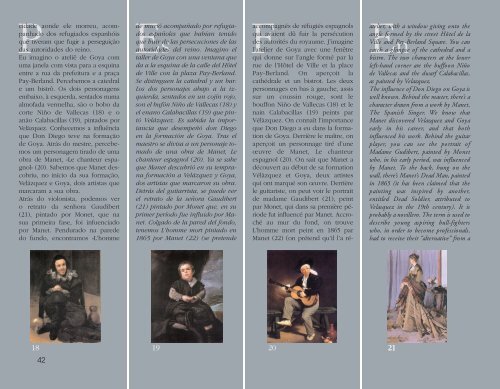couv 2010:couv 2010, page 1 @ Preflight - Herman BRAUN-VEGA
couv 2010:couv 2010, page 1 @ Preflight - Herman BRAUN-VEGA
couv 2010:couv 2010, page 1 @ Preflight - Herman BRAUN-VEGA
You also want an ePaper? Increase the reach of your titles
YUMPU automatically turns print PDFs into web optimized ePapers that Google loves.
P F<br />
cidade aonde ele morreu, acom- de murió acompañado por refugiapanhado<br />
dos refugiados espanhóis dos españoles que habían tenido<br />
que tiveram que fugir a perseguição Es<br />
que huir de las persecuciones de las<br />
das autoridades do reino.<br />
autoridades del reino. Imagino el<br />
Eu imagino o ateliê de Goya com<br />
uma janela com vista para a esquina<br />
entre a rua da prefeitura e a praça<br />
Pay-Berland. Percebemos a catedral<br />
e um bistrô. Os dois personagens<br />
embaixo, à esquerda, sentados numa<br />
almofada vermelha, são o bobo da<br />
corte Niño de Vallecas (18) e o<br />
anão Calabacillas (19), pintados por<br />
Velázquez. Conhecemos a influência<br />
que Don Diego teve na formação<br />
de Goya. Atrás do mestre, percebemos<br />
um personagem tirado de uma<br />
obra de Manet, «Le chanteur espagnol»<br />
(20). Sabemos que Manet descobriu,<br />
no início da sua formação,<br />
Velázquez e Goya, dois artistas que<br />
marcaram a sua obra.<br />
Atrás do violonista, podemos ver<br />
o retrato da senhora Gaudibert<br />
(21), pintado por Monet, que na<br />
sua primeira fase, foi infuenciado<br />
por Manet. Pendurado na parede<br />
do fundo, encontramos «L’homme<br />
taller de Goya con una ventana que<br />
da a la esquina de la calle del Hôtel<br />
de Ville con la plaza Pay-Berland.<br />
Se distinguen la catedral y un bar.<br />
Los dos personajes abajo a la izquierda,<br />
sentados en un cojín rojo,<br />
son el bufón Niño de Vallecas (18) y<br />
el enano Calabacillas (19) que pintó<br />
Velázquez. Es sabida la importancia<br />
que desempeñó don Diego<br />
en la formación de Goya. Tras el<br />
maestro se divisa a un personaje tomado<br />
de una obra de Manet, Le<br />
chanteur espagnol (20). Ya se sabe<br />
que Manet descubrió en su temprana<br />
formación a Velázquez y Goya,<br />
dos artistas que marcaron su obra.<br />
Detrás del guitarrista, se puede ver<br />
el retrato de la señora Gaudibert<br />
(21) pintado por Monet que, en su<br />
primer período fue influido por Manet.<br />
Colgado de la pared del fondo,<br />
tenemos L’homme mort pintado en<br />
1865 por Manet (22) (se pretende<br />
accompagnés de réfugiés espagnols<br />
qui avaient dû fuir la persécution<br />
des autorités du royaume. J’imagine<br />
l’atelier de Goya avec une fenêtre<br />
qui donne sur l’angle formé par la<br />
rue de l’Hôtel de Ville et la place<br />
Pay-Berland. On aperçoit la<br />
cathédrale et un bistrot. Les deux<br />
personnages en bas à gauche, assis<br />
sur un coussin rouge, sont le<br />
bouffon Niño de Vallecas (18) et le<br />
nain Calabacillas (19) peints par<br />
Vélàzquez. On connaît l’importance<br />
que Don Diego a eu dans la formation<br />
de Goya. Derrière le maître, on<br />
aperçoit un personnage tiré d’une<br />
œuvre de Manet, Le chanteur<br />
espagnol (20). On sait que Manet a<br />
dé<strong>couv</strong>ert au début de sa formation<br />
Vélàzquez et Goya, deux artistes<br />
qui ont marqué son œuvre. Derrière<br />
le guitariste, on peut voir le portrait<br />
de madame Gaudibert (21), peint<br />
par Monet, qui dans sa première période<br />
fut influencé par Manet. Accroché<br />
au mur du fond, on trouve<br />
L’homme mort peint en 1865 par<br />
Manet (22) (on prétend qu’il l’a ré-<br />
atelier, with a window giving onto the<br />
angle formed by the street Hôtel de la<br />
Ville and Pay-Berland Square. You can<br />
En<br />
18 19 20 21<br />
42<br />
catch a glimpse of the cathedral and a<br />
bistro. The two characters at the lower<br />
left-hand corner are the buffoon Niño<br />
de Vallecas and the dwarf Calabacillas,<br />
as painted by Velazquez.<br />
The influence of Don Diego on Goya is<br />
well known. Behind the master, there’s a<br />
character drawn from a work by Manet,<br />
The Spanish Singer. We know that<br />
Manet discovered Velazquez and Goya<br />
early in his career, and that both<br />
influenced his work. Behind the guitar<br />
player, you can see the portrait of<br />
Madame Gudibert, painted by Monet<br />
who, in his early period, was influenced<br />
by Manet. To the back, hung on the<br />
wall, there’s Manet’s Dead Man, painted<br />
in 1865 (it has been claimed that the<br />
painting was inspired by another,<br />
entitled Dead Soldier, attributed to<br />
Velasquez in the 19th century). It is<br />
probably a novillero. The term is used to<br />
describe young aspiring bull-fighters<br />
who, in order to become professionals,<br />
had to receive their “alternative” from a


